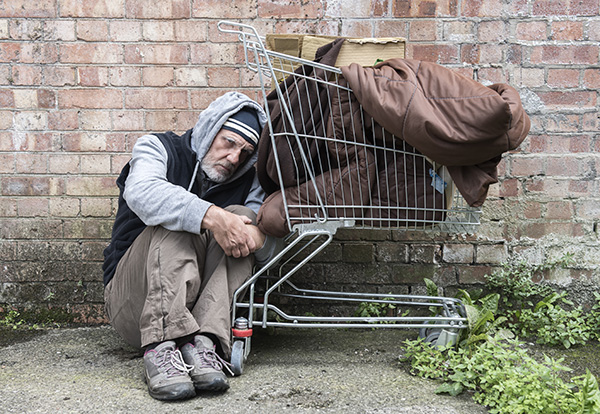Understanding Homelessness
The causes and consequences of homelessness are complex. Homelessness affects a diverse cross-section of the population that includes youth, women with children, and seniors. Understanding homelessness requires a grasp of several social issues: poverty, affordable housing, disabilities, and others. Homelessness occurs when people or households are unable to acquire and/or maintain housing they can afford.
While circumstances can vary, the main reason people experience homelessness is because they cannot find housing they can afford. It is the scarcity of affordable housing in the United States, particularly in more urban areas where homelessness is more prevalent, that is behind their inability to acquire or maintain housing.
A look at the numbers:
In January 2014, there were 578,424 people experiencing homelessness on any given night in the United States. Of that number, 216,197 are people in families, and 362,163 are individuals.
About 15 percent of the homeless population – 84,291 – are considered “chronically homeless” individuals, and about 9 percent of homeless people- 49,933 – are veterans.
These numbers come from point-in-time counts, which are conducted, community by community, on a single night in January every other year. The Department of Housing and Urban Development (HUD) requires communities to submit this data every other year in order to qualify for federal homeless assistance funds. Many communities conduct counts more regularly.

Areas of Focus
Families
Homeless families are similar to other poor families. Typically, families become homeless as a result of some unforeseen financial crisis – a medical emergency, a car accident, a death in the family – that prevents them from being able to hold on to housing.
Most homeless families are able to bounce back from homelessness quickly, with relatively little public assistance. Usually, homeless families require rent assistance, housing placement services, job assistance, and other short-term, one-time services before being able to return to independence and stability.
For more information about homeless families, solutions to family homelessness, and policies addressing the issue, please visit the families section of The National Alliance to End Homelessness’s website.
Youth
Young people often become homeless due to family conflict, including divorce, neglect, or abuse. A large majority of young people experience short-term homelessness, returning back home or to family/friends.
Youth homelessness presents a particular challenge for several reasons, including the fact that there is very little definitive data on the population, as this group often doesn’t interact with standard homeless assistance programs or government agencies. Moreover, the solutions that have been identified for homelessness in general are often not applicable to minors (who are, for example, ineligible to rent an apartment). These special challenges mean that solutions to youth homelessness require innovation.
There has been specific interest to the LGBTQ youth experiencing homelessness who have specific needs and are at heightened risk of harm as compared to their heterosexual homeless youth counterparts.
Veterans
Veterans often become homeless due to war-related disabilities. For a variety of reasons – physical disability, mental anguish, post-traumatic stress, etc. – many veterans find readjusting to civilian life difficult. Difficulties readjusting can give rise to dangerous behaviors, including addiction, abuse, and violence, which, coupled with the difficulties, can lead to homelessness.
Preventive measures, including job placement services, medical services, housing assistance, and the like, can mitigate the risk of veterans experiencing homelessness.
For more information about veteran homelessness, please visit the veteran section of HUD’s website.
Chronic Homelessness
Chronic homelessness is often the public face of homelessness. “Chronic” has a specific definition, involving either long-term and/or repeated bouts of homelessness coupled with disability (physical or mental). People experiencing chronic homelessness often end up living in shelters and consume a plurality of the homeless assistance system’s resources.
It’s a common misconception that this group represents the majority of the homelessness population. Rather, they account for less than 15 percent of the entire homeless population on a given day.
Fortunately, there has been significant progress to address chronic homelessness in the last decade. The number of individuals experiencing chronic homelessness has declined by 21 percent since 2010.
For more information on chronic homelessness, please visit National Alliance to End Homelessness or HUD’s Website.
Details, Notes, and References
The National Alliance to End Homelessness published a report on the Geography of Homelessness, which examines the prevalence of homelessness in different geographic types: rural, urban, suburban, and those in between.
In 2014, Housing First, Inc. released Ten Year Plan to End Homelessness to provide a plan and direction for the communities of Baldwin and Mobile Counties to meet these needs for this segment of our population for the next 10 years.
The recession has impacted homelessness. In 2007, the National Alliance to End Homelessness made a prediction about the projected increase of homelessness resulting from the recession. They issued a report examining those impacts early in 2011.
You Can Help End Homelessness With a Donation
Make our community a place where no one experiences homelessness. Donate today because you believe everyone deserves a safe place to sleep at night.
Admin Office
107 St. Francis Street
Suite 1970
Mobile, AL 36602
Phone: 251-450-3345
Housing Assistance/
Downtown Office
279 N. Washington Ave., Bldg. 3
Mobile, AL 36603
251-450-3345
coordinatedentry@hfal.org
Downtown Office
